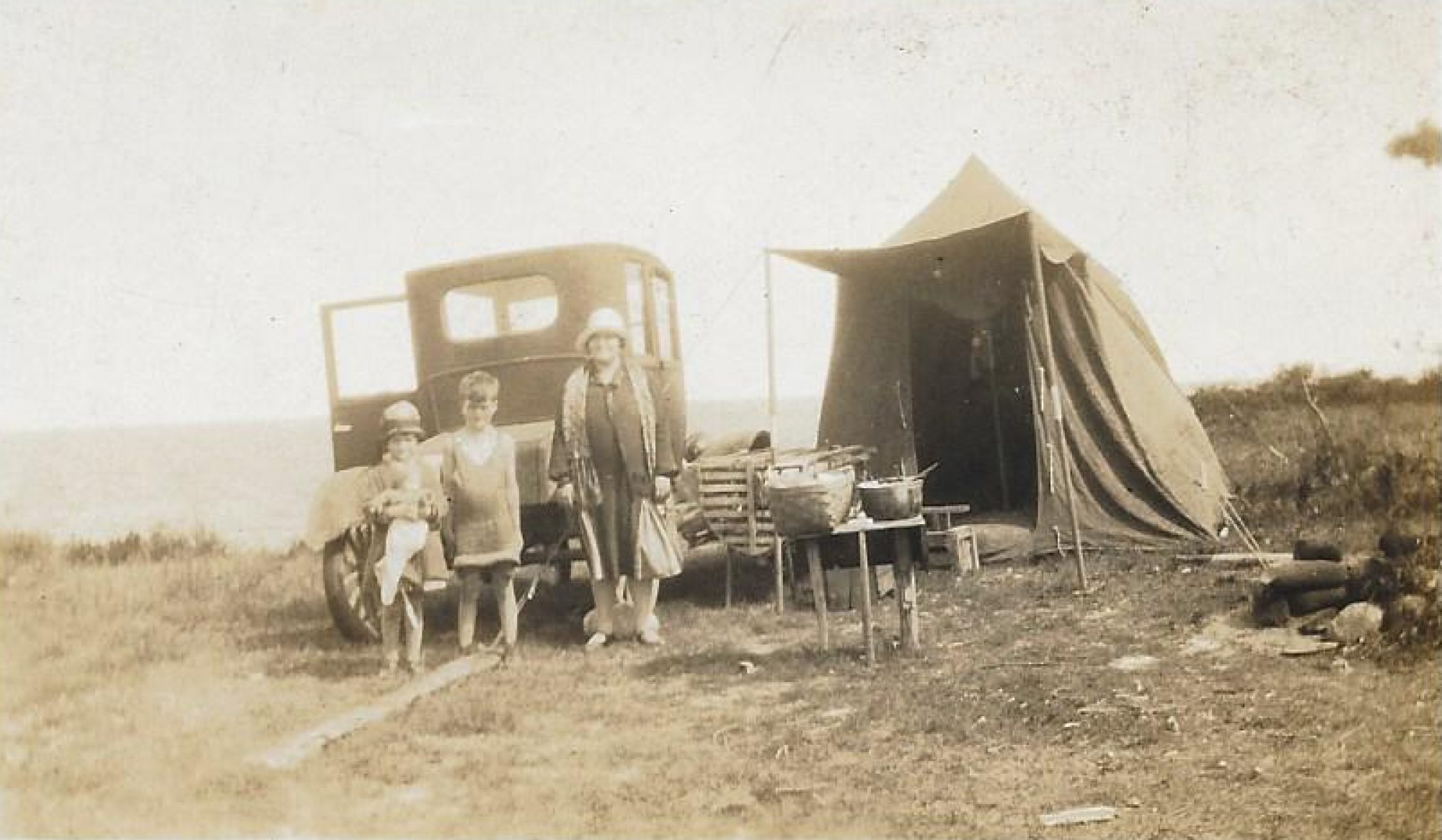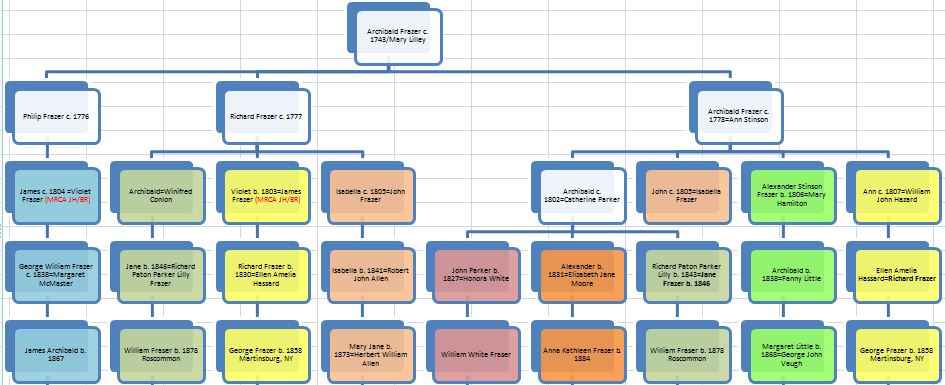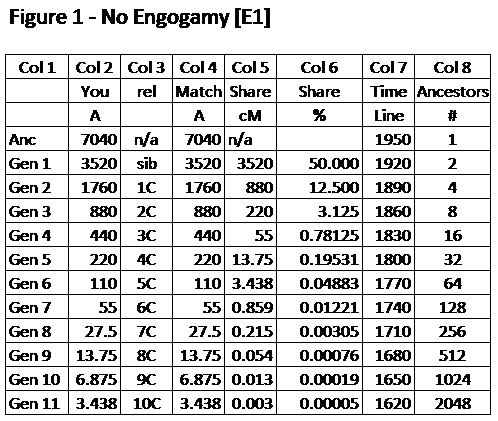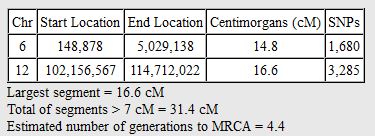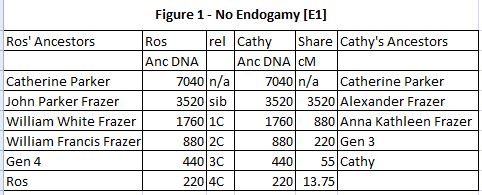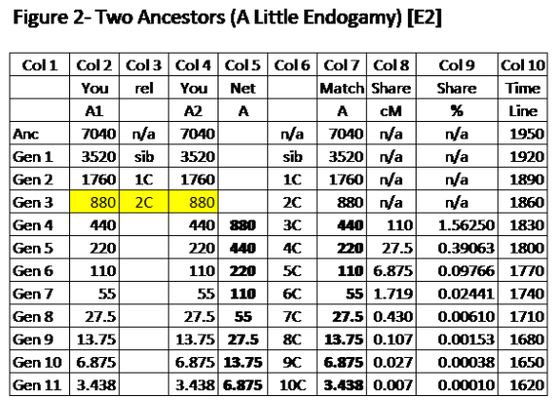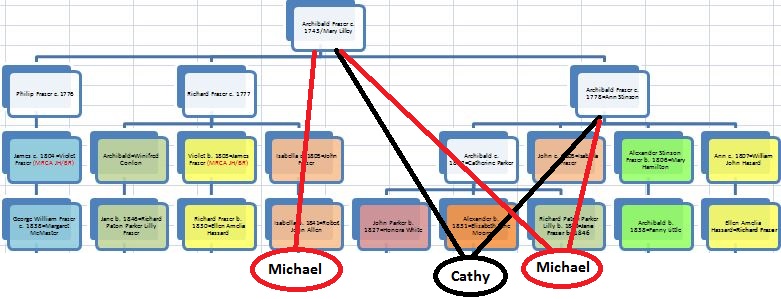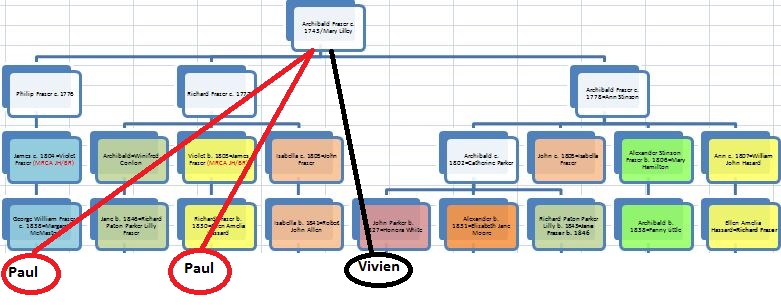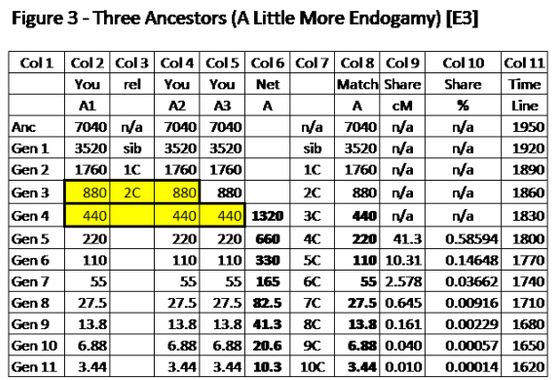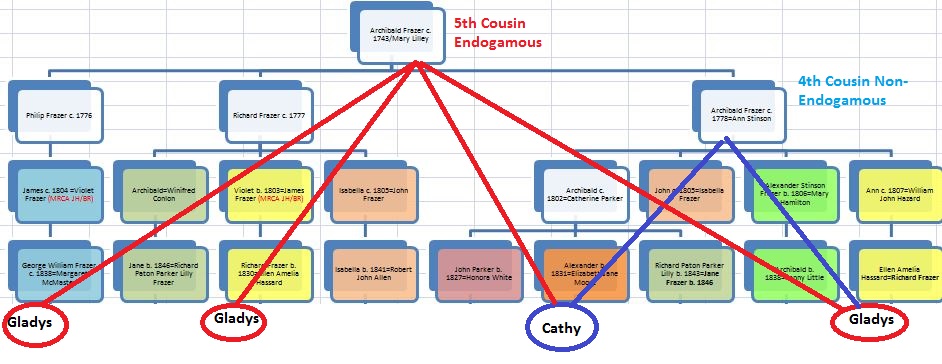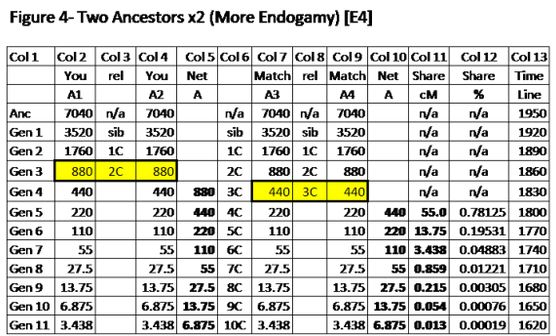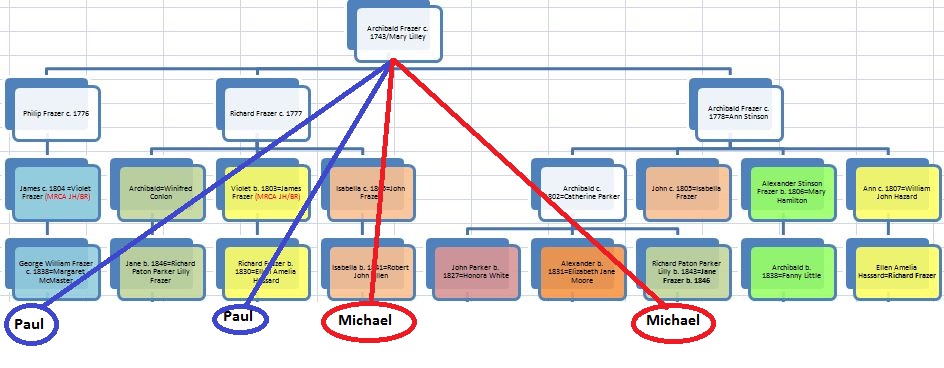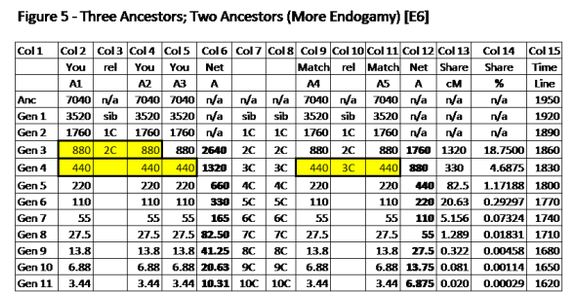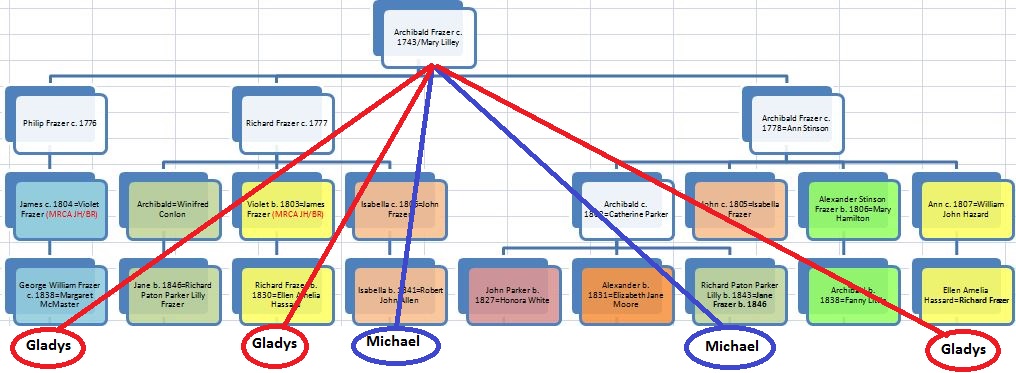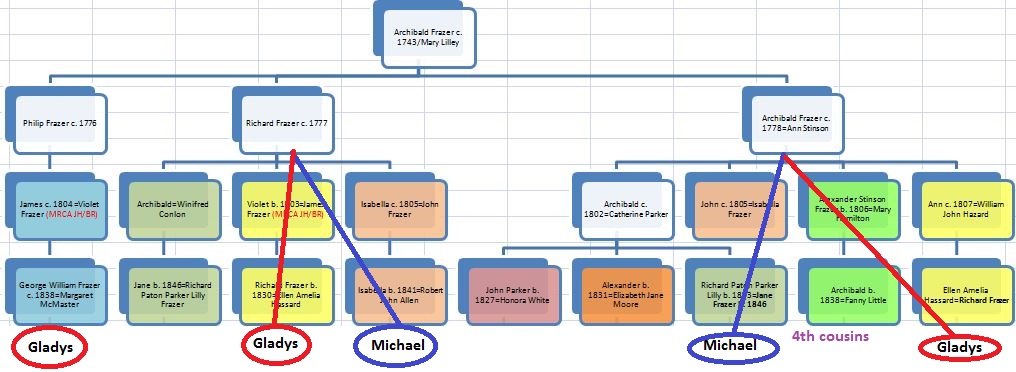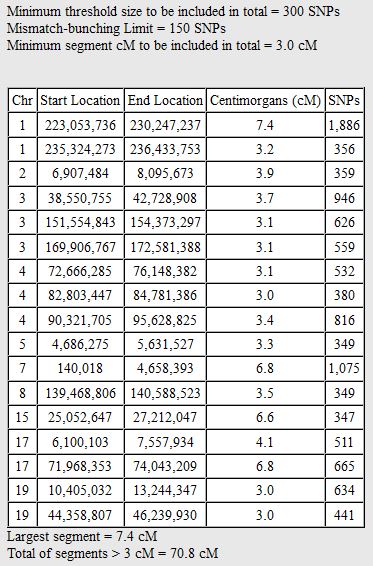I had written a blog quite a while back (July 2015) on Frazer Endogamy. In the Archibald Line of the Frazer DNA Project at least, there were some Frazer ancestor cousins that married. This creates more DNA for the project and more confusion in figuring out what DNA came from which ancestor. Since my earlier blog, Jim Bartlett has written two interesting blogs on Endogamy at his Segmentology Blog site.
I actually started out trying to write a blog on Frazer Triangulation Groups.
As a part of writing about Triangulation, I tried counting all the Frazer relationships. This was not as easy as I thought.
Then I saw that I needed to understand endogamy better before I could look at either Triangulation Groups or Frazer relationships. In this Blog, I’ll go through the Segmentolgy Blog from December 2015 called Endogamy: Part I. I will insert Frazer examples in place of the theoretical examples used.
Here’s a simplified view of the Archibald Line:
For example, it doesn’t show that George Frazer, my second great grandfather in the middle blue box is the brother of Richard Frazer in the first middle yellow box. Here are the Archibald Line testers from the Frazer DNA Project. Jean is the daughter of Vivien, so isn’t included here:
The testers in the colored groups are in more than one line so they appear more than one time. That’s the endogamy part. Here is the Segmentology Blog’s Figure 1:
This shows the case with no endogamy. The chart has a lot of information on it. It shows how much DNA one gets from one parent (half). It shows how much DNA siblings share (half). In every generation, the theoretical amount that is shared by you and your match is 1/4 of the previous generation. In the Frazer project, a lot of our matches are in the 4th cousin or 5th cousin level. Between these two levels of matches, the level of average match goes from 13.75 cM to 3.438 cM. As many of you know, 7 cM is a normal threshold for establishing matches. Fortunately, these are averages and we do have matches at the 5th cousin level in many cases. I won’t be using Columns 6-8 in my example.
Frazer Endogamy by the Numbers
Frazer E1 example – no endogamy
For this example, we will have to choose a match between Ros, Vivien, Cathy or Doug as the other testers descend from multiple Frazer Lines. I’ll pick Ros and Cathy. I have that they are 3rd cousins, once removed. Here is how they actually match:
Their common ancestor (Anc) is Archibald Frazer and Catherine Parker. I have to pick an ancestor for the example, so I’ll pick Catherine Parker.
I tried to make this chart look like Jim Bartletts, but added in actual ancestors on Ros and Cathy’s sides. This says that their assumed ancestor Catherine Parker passed down 220 cM of DNA to Ros and 440 cM to Cathy. However, the amount that we share with a match is much less than the total DNA that we inherit. Ros and Cathy share halfway between theoretical 55 cM and 14 cM shown in the chart above. Halfway is about 34 cM which is pretty close to what gedmatch showed for an actual match between the two at 31.4 cM. Gedmatch thought that Ros and Cathy should be 4.4 generations to a common ancestor. They are actually a tiny bit further out at 4.5 generations.
Frazer E2 example – Two ancestors (a little endogamy) [e2]
Again I’m borrowing Jim Bartlett’s Segmentology Blog wording and adapting it for the Frazer Program. Here is Jim’s Figure 2 from his Endogamy Blog:
Here he added an extra column and a splash of color. The example here has one person with a double descent from an ancestor matching or being related to another person. This happened when two second cousin married and had children. It is important to know that the A1, A2 on ‘your’ side and A on the match side above are all the same ancestor being matched. Here the same DNA gets passed down to all the children, but the amount that gets passed down to the children of parents that are related to each other is doubled. This has the net result of doubling the expected match also. The yellow represents second cousins that married. In our example, we will use 1st cousins.
For the Match Column on the right, we will need to pick from those who don’t have multiple Frazer ancestors. Let’s try Cathy with one Frazer ancestor and Michael with 2 Frazer ancestors.
Here Cathy and Michael share 16.7 cM on Chromosome 15. Their Most Recent Common Ancestors (MRCAs) are as shown. This is where it can get a little confusing. (I sure was.) They only share those ancestors in a non-endogamous way – that is, in the E1 example above. To get to the endogamous situation, we have to back another generation. Michael’s ancestors, John and Isabella Frazer married. They were 1st cousins, so their common ancestors were their grandparents. Those grandparents were Archibald Frazer and Mary Lilley. Here is what I get:
When Isabella was born in 1841, she got a double dose of Frazer DNA from her parents. This is shown in the net column.
Michael and cathy are non-endogamous Fourth cousins and endogamous Fifth Cousins
Note that there are 2 different things going on here. First, Michael and Cathy are related as fourth cousins through Archibald Frazer b. about 1778 and Ann Stinson. This is not endogamous as neither of those ancestors appear multiple times in Michael’s ancestry. However, because this relationship is closer at 4th cousin, the expected match would be around 14 cM as per figure 1. Here, the further out endogamous relationship only results in a suspected match of about 7 cM which is right about at the level one would even start seeing a match. If not for endogamy, this match would only be half that amount. So which match are we seeing? I would expect that it would be the closer 4th cousin match.
Here is a representation of the issue:
The left red line actually goes through the Richard Frazer box on the second row. The middle red line goes through the Archibald in the uncolored box in the second row on the right. This shows how Michael and Cathy are 4th cousins once, but 5th cousins twice by endogamy. What happened here is that the endogamy boosted the 5th cousin theoretical shared amount by 2. In summary Michael and Cathy’s theoretical average matches would be expected to be:
- 4th Cousin [E1] – 14 cM
- 5th Cousin [E2] – 7 cM
Frazer E2 example (second try) – Two ancestors (a little endogamy) [e2]
While out on a training run, I came up with a better idea. I’ll take my cousin Paul, who doesn’t descend from the same group on the right and match him with a non-endogamous Frazer tester. That will be much clearer. Here is Paul from the Philip and Richard Lines and Vivien from the Archibald/Stinson Line.
They are both 5 generations from Archibald Frazer and Mary Lilley. Gedmatch shows them at 4.9 generations. The chart looks the same:
The path of the relationships is clearer:
Perhaps, were it not for endogamy, Paul and Vivien would not have matched by DNA at all. Here there theoretical match would be about 7 cM (vs. about 3.5 cM without endogamy). Their actual match was 15 cM.
Three Frazer ancestors (a little more endogamy) [e3]
Here, we will take Gladys who descends from 3 Frazer Lines and compare her with Cathy. Again, we will have the issue where Gladys and Cathy will be 4th and 5th cousins. Let’s just look at the 5th cousins as that is where the endogamy is. Gladys and Cathy match like this:
Gedmatch has them at a little better than 4th cousins.
Here is our Segmentology Example:
The above chart represents 2 cousin marriages shown in yellow. Second cousins marry in Gen 3 and then their child marries another cousin in Gen 4. This is sort of what happened in Gladys’ ancestry. She had first cousins James and Violet Frazer (also my ancestors) marry. Then their son Richard married Amelia Hassard who was the daughter of Ann Frazer. Ann Frazer was another first cousin of James and Violet Frazer. So Richard Frazer married his 2nd cousin. However, due to Richard’s parents being cousins, Amelia was his second cousin twice – or two different ways.
Here’s our Frazer E3 Example:
I still have chosen the common ancestor as Mary Lilley (though it could be Archibald Frazer). I don’t have Gladys’ ancestors by name as there are 3 sets of ancestors there. The end result is that Gladys and Cathy should share a total of 10.3 cM through this 5th cousin endogamous relationship. Normally 6th cousins would share 1/3 this amount.
Where did the matching dna come from?
There are 3 chances to make it to a total of 10.3 cM in the endogamous red line 5th cousin relationships. That means a possible 3 different segments of about 3.5 cM each. There is only one chance that Gladys could match Cathy at 4th cousin for a 14 cM likely match. As Gladys and Cathy match on one segment, I think that the match may be from the 4th cousin relationship shown by the blue lines above. That non-endogamous relationship should average a match of about 14 cM. Gladys and Cathy had an actual match of about 15 cM.
Two frazer ancestors X 2 (more endogamy) [e4]
What has happened here? We see a situation where one person has ancestors that were 2nd cousins matches another person who has ancestors that were 3rd cousins. Looking at the 3rd row, those ancestors were A1 through A4. The catch is that A1, A2, A3 and A4 are all the same ancestor. I’m sure we have a similar situation in our Frazer DNA Project. One example of that would be Paul matching Michael. Here is how they match:
According to Gedmatch, Paul and Michael look like 3rd cousins based on the level that they matched by DNA. Based on our genealogy charts, they are 4th or 5th cousins. Above I show the E4 Endogamy situation. That is, Paul with Archibald (top box) as his ancestor twice is related to Michael (who has red lines going twice to Archibald in the top box also). Those all represent 5th cousins. In addition Paul and Michael are 4th cousins going up to Richard Frazer. I don’t show that as it would get too messy.
Actually, the 5th cousin relationship doesn’t explain the large match. The 5th cousin E4 only results in 14 cM. Paul and Michael are also 4th cousins also, but it is not an endogamous match. The best I understand this is that Paul and Michael should share:
- 14 cM due to a non-endogamous 4th cousin relationships with Richard Frazer as Common Ancestor
- A total of 14 cM due to an E4 engamous relationshipe with Archibald Frazer and Mary Lilley as common ancestors.
To show that Paul and Michael are not a fluke, here are some other matches:
These are all project member in a Triangulation Group with E4 Endogamy and 4th cousin or 4th cousin, once removed relationships. As Michael (MFA), Jane, Paul (PF) and my sister Heidi (HHM) all have similar match numbers and are all in a Triangulation group, we can assume similar endogamy and ancestors for each. In fact, Jane was added to this group early on in the Frazer DNA Project due to the Triangulation.
Let’s move on to the next level of endogamy, to see if that makes more sense.
Three frazer ancestors; Two Frazer Ancestors(more endogamy) [e6]
Again, I borrow the figure from the Segmentology Endogamy Part I Blog:
Fortunately, the Frazers also have this situation. We can use Gladys on the left hand side. One the right we have the choice of Michael or Paul. I’d rather use Michael, as Gladys and Paul are related in additional ways that might make the example more confusing.
The above chart shows 6 endgamous 5th cousin relationships between Gladys and Michael. There are also two 4th cousin non-endogamous relationships between the two (represented below). One has Richard Frazer as the common ancestor. The other has Archibald Frazer and Ann Stinson as common ancestors.
I enter Gladys and Michael in at Gedmatch at get:
Now that is a surprise. An E4 at 5th cousin got an actual match of 54. This E6, 5C match got only 7.4 cM?
In summary, Gladys and Michael have:
- 6 – 5th cousin relationships for a theoretical total of 20.6 cM
- 2 – 4th cousin relationships of about 14 cM each
To satisfy my curiosity, I ran Gladys and Michael at a low threshold of 3 cM and got many matches at gedmatch.com.
I expect the matches above 6 may be valid. The Chromosome 1 match is in a defined Triangulation Group (TG) with the common ancestor of Richard Frazer. The Chromosome 7 match is in an area where there is already a match with Vivien of our project. She has as her ancestor Archibald Frazer and Ann Stinson. So the Chromosome 7 match above likely represents those common ancestors. The Chromosome 15 and 17 matches over 6 cM also likely represent the Frazer/Stinson Line. All this is to say at the 8 potential relationships we showed above for Gladys and Michael, we can find DNA evidence for 4 DNA matches.
So that is enough on Frazer endogamy for now.
Some notes and summaries
- Endogamy from the Archibald Line of the Frazer project account for many additional relationships and chances for DNA matching
- The theory of endogamy as set out in the Segmentology blog seems to be consistent with the Frazer relationships and DNA matches
- One set of matches that endogamy did not account for was the many high Frazer matches that also form a Triangulation Group in Chromosome 1. These actual DNA matches were well above what would have been predicted
- By lowering the gedmatch thresholds, it may be possible to see additional endogamous matches where they were predicted by additional endogamous relationships
- These extra endogamous relationships seem to be responsible for the many Triangulation Groups in the Frazer DNA Project
- This exercise reinforces that relationships are based on Common Ancestors.
- This Blog has also helped to sort out some confusing relationships and clear up which relationships are endogamous and which ones aren’t – and at what level of cousin-ship they are at.
